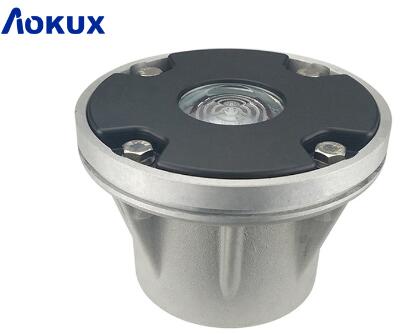
Helicopter landing pads (helipads) play a vital role in various sectors, including emergency medical services, corporate aviation, offshore operations, and military applications. These specialized platforms require meticulous design and equipment to ensure safe and efficient helicopter operations. Among the most critical components of a helipad are the landing pad lights. These lights are essential for guiding pilots during takeoff, landing, and ground operations, particularly in low-visibility conditions. This article delves into the importance of helicopter landing pad lights, their different types, technological advancements, and the regulatory standards that govern their use.
Importance of Helicopter Landing Pad Lights
Helicopter landing pad lights are crucial for several reasons:
Enhancing Pilot Visibility
Landing pad lights ensure that pilots can clearly see the helipad, its boundaries, and any potential obstacles. This is especially important during nighttime operations or in adverse weather conditions, where visibility is significantly reduced. Proper lighting minimizes the risk of accidents and enhances the overall safety of helicopter operations.
Facilitating Accurate Navigation
These lights provide essential visual cues that help pilots align their approach and departure paths accurately. Clear demarcation of the landing zone, approach paths, and obstacles enables pilots to execute precise maneuvers, ensuring safe landings and takeoffs.
Increasing Operational Efficiency
Well-illuminated helipads allow for continuous operations, regardless of the time of day or weather conditions. This is particularly critical for emergency services and other time-sensitive missions where helicopters need to operate around the clock. Efficient lighting systems ensure that these operations can be carried out without interruption, potentially saving lives and resources.

Ensuring Compliance with Safety Regulations
Aviation authorities, such as the Federal Aviation Administration (FAA) and the International Civil Aviation Organization (ICAO), have established stringent standards for helipad lighting. Compliance with these regulations is mandatory to ensure the safety and reliability of helicopter operations. Properly installed and maintained lighting systems help operators meet these regulatory requirements and avoid penalties.
Types of Helicopter Landing Pad Lights
Various types of lights are used on helicopter landing pads, each serving a specific purpose. These lights can be broadly categorized into perimeter lights, approach lights, touchdown and lift-off area (TLOF) lights, and obstruction lights.
Perimeter Lights
1. White Perimeter Lights: These lights outline the edges of the helipad, providing a clear visual boundary for pilots. Typically steady-burning and placed at regular intervals, they ensure that the landing area is easily identifiable from the air.
2. Green Threshold Lights: Positioned at the designated entrance points of the helipad, green threshold lights indicate the preferred landing direction. They assist pilots in aligning their approach correctly, ensuring safe landings within the designated area.
Approach Lights
1. Approach Path Indicator Lights: These lights guide pilots during the final approach to the helipad. They are typically arranged in a straight line leading to the landing area, helping pilots maintain the correct glide slope and alignment.
2. Final Approach and Takeoff (FATO) Lights: FATO lights mark the edges of the final approach and takeoff area. Usually white, these lights provide visual guidance during the critical phases of landing and takeoff.
Touchdown and Lift-Off Area (TLOF) Lights
1. TLOF Lights: These green lights mark the exact spot where the helicopter's wheels or skids should touch down. They provide a precise target for pilots during landing, ensuring accurate touchdowns.
Obstruction Lights
1. Red Obstruction Lights: Installed on structures around the helipad, such as buildings, towers, or cranes, these lights warn pilots of potential hazards. They are typically red and flash at regular intervals to draw attention to obstacles that could pose a risk during approach or departure.
Windsock Lights
1. Illuminated Windsocks: Windsocks, which indicate wind direction and speed, are often illuminated to ensure visibility during nighttime operations. Properly lit windsocks provide pilots with essential information about wind conditions, helping them make informed decisions during landing and takeoff.
Technological Advancements in Helicopter Landing Pad Lights
Advancements in lighting technology have significantly improved the performance, durability, and efficiency of helicopter landing pad lights. Some of the notable advancements include:
LED Lighting
Light-emitting diode (LED) technology has revolutionized helipad lighting. LED lights are highly energy-efficient, consuming less power than traditional incandescent or halogen lights. They also have a longer lifespan, reducing maintenance costs and downtime. Additionally, LED lights provide brighter and more consistent illumination, which is crucial for ensuring visibility in all conditions.
Solar-Powered Lights
Solar-powered helipad lights offer a sustainable and cost-effective solution, particularly in remote or off-grid locations. These lights are equipped with solar panels that charge during the day and provide illumination at night. Solar-powered systems reduce the reliance on external power sources and can operate independently, making them ideal for temporary or emergency helipads.
Remote Control and Automation
Modern helipad lighting systems can be equipped with remote control and automation features, allowing operators to adjust lighting settings based on specific needs. Remote control systems enable the activation or deactivation of lights from a distance, while automated systems can adjust the brightness or flashing patterns based on ambient light conditions or pre-set schedules. These features enhance the flexibility and responsiveness of helipad lighting systems.
Smart Lighting Systems
Smart lighting systems integrate advanced sensors and control mechanisms to optimize lighting performance. These systems can adjust light intensity based on real-time conditions, such as weather and ambient light levels. They can also be programmed to respond to specific operational scenarios, ensuring optimal visibility and safety at all times.
|
helicopter landing pad lights |
inset light |
| 23 | 25 |
| 26 | 44 |